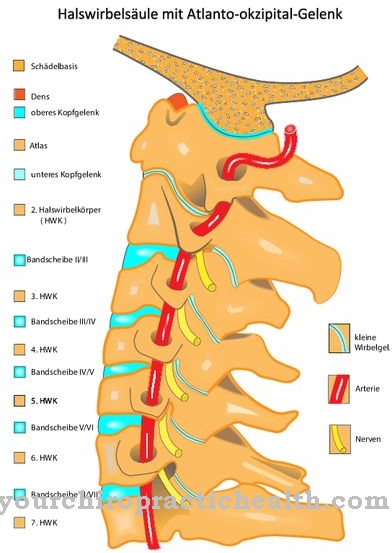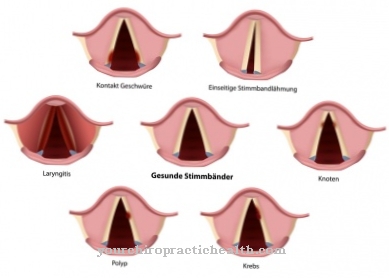A disc prolapse is a degenerative and wear-related disease of the intervertebral discs and lumbar spine or cervical spine. This mainly leads to deformations and bruises on the individual vertebral bodies. This process can cause severe pain and radiate to the extremities (arms, legs, feet).
What is a herniated disc?

Older people in particular today suffer from problems with their intervertebral discs. These herniated discs, most of which are affected, are due to complications in the lumbar or cervical spine. Most of the time, a herniated disc occurs as a result of wear and tear on the intervertebral discs. The elastic buffers that sit between the vertebrae of the spine wear out over time. Since the spine is now directly exposed to shocks and shock absorbers, the vibrations can no longer be absorbed by the intervertebral discs.
If the lumbar spine shows signs of wear and tear, severe and stabbing pain occurs in the back or legs, while the shoulders, arms and hands are particularly affected in cervical vertebrae prolapsed. In addition to the pain, patients often experience sensory disturbances such as numbness or tingling. Problems in the genital and anus areas, which require urgent medical help, also occur less frequently.
Older people in particular (from the age of 45) suffer from herniated discs, as their lumbar spine and cervical spine have increased wear and tear as they get older.
causes
The causes of a herniated disc are based on the wear and tear of the disc, which can then come to light, especially in older people. Younger people can also get this disease, but the causes are more likely to be traced back to general injuries or overuse.
If the load is sustained, intervertebral disc material penetrates existing cracks and the adjacent longitudinal ligament can break through. The gelatinous consistency of the intervertebral disc is destroyed and its function as a buffer between the bones is severely decimated. The particles can now constrict the spinal cord or spinal nerves and thus cause severe pain or sensory disorders.
General external causes, in addition to the signs of wear and tear in old age, are obesity and continuous improper stress on the spine (e.g. constant incorrect sitting in the office). A lack of good back muscles can also promote herniated discs.
Symptoms, ailments & signs
Not every herniated disc causes symptoms. Their occurrence and extent depend on whether nerve structures are affected and to what extent this happens. Therefore, many people have a herniated disc without suffering from any symptoms.
Symptoms show when it puts pressure on a nerve root. The consequence of this is usually severe back pain. In addition, the muscles in the body region that is affected by the prolapse harden. If the herniated disc occurs in the lumbar spine (lumbar spine), the pain can sometimes spread to other parts of the body.
This usually includes the leg or buttocks. Some patients also have a tingling sensation in their legs. Furthermore, symptoms of paralysis in the leg muscles are possible. If the person concerned suffers from a herniated disc in the cervical spine (cervical spine), this often results in neck pain that radiates to the back of the head, arm or hand.
Another common symptom is sensory disorders such as numbness, a feeling of cold or tingling in the affected limbs. In the case of a herniated disc, there is also a risk of failure and muscle weakness in the legs or feet. There is a risk that the patient will stumble for no reason or suddenly collapse when climbing stairs. In most cases, the symptoms are in the lumbar spine. In contrast, they are much less common in the neck and chest region.
course
As the disease progresses with a herniated disc, the symptoms can worsen and the symptoms worsen.
Chronic complaints can also develop. In many cases, however, a herniated disc remains undetected and is therefore not treated by a doctor.
The course of a herniated disc is usually part of the therapy or treatment. Conservative therapy is particularly promising. Surgical interventions only need to be used in exceptional cases if there are severe complications.
Surgery should be resorted to, especially in the case of lasting damage, such as inflammation of blood vessels and nerve cells.
Complications
Various complications can arise in connection with a herniated disc. Complications usually arise when the patient waits too long before starting therapy. In the course of a herniated disc, the pain can increase. In addition, numbness, weakness or abnormal sensations can occur in the affected parts of the body.
Other parts of the body can also be affected. For example, a herniated disc in the neck area can lead to reduced strength and sensitivity disorders in the arms. The nerve damage can also lead to paralysis of the bowel and bladder. As a result, the patient has problems urinating and defecating.
Pain associated with a herniated disc can cause muscle tension. As a result, the joints are improperly stressed and further pain occurs. The clinical picture is getting worse. The pain can also become chronic after the herniated disc has been resolved.
If a herniated disc is not treated, it will become bigger and bigger because the disc continues to be stressed and more disc contents are pressed into the spinal canal. Pain increases. If the herniated disc is very large, the blood supply to the nerve root is often pinched off. Root death then occurs.
Pain is not passed on, the patient has fewer complaints. However, there is also no flow of information to the corresponding muscles. The muscles are numb.
When should you go to the doctor?
If a herniated disc is suspected, a doctor should be consulted immediately. If back pain persists for more than three to five days or keeps coming back, a doctor must clarify the cause. This is especially true if the pain radiates into the arms and legs or signs of paralysis in the limbs and lower body are added. Back pain after an accident or lumbago also indicate a herniated disc and should be clarified quickly.
People who move little or sit a lot at work, lift large loads or generally perform physically demanding activities should have any back problems examined. A quick diagnosis can usually treat harmless back pain and herniated discs well.
If the back pain is accompanied by a poor general condition or other symptoms such as fever and weight loss occur, this indicates a serious underlying condition. A visit to the family doctor should then no longer be postponed. Physiotherapists, orthopedists, chiropractors or rheumatologists are other contacts in the event of a herniated disc.
Doctors & therapists in your area
Treatment & Therapy
Therapy for a herniated disc can only be carried out by a doctor. The diagnosis is carried out with the help of computed tomography (CT) or magnetic resonance imaging (MRT).
As a rule, the therapy takes place without surgery. Rather, a change in lifestyle, pain therapy and rest of the affected areas are addressed.
Above all, the spine should be less stressed and relieved by aids. A neck cuff and a step bed are particularly suitable for this. In addition to general pain relief, it is also advisable to support the damaged areas through targeted muscle building through gymnastics and physiotherapy. Above all, the back muscles should be trained here.
However, if nerve damage has already occurred, the intervertebral disc material must be surgically removed. However, this form of treatment is used in only 10% of all herniated discs. Part of the broken disc is then removed.
prevention
There is no one hundred percent functioning prevention. Still, may prefer a lifestyle that minimizes the risk of herniated discs. This includes:
- General muscle training to relieve the spine
- No overweight
- Avoidance of excessive strain (e.g. carrying weights that are too heavy)
- Little sitting, lots of exercise (or ergonomic seating)
Outlook & forecast
The prognosis and outlook for a herniated disc can vary greatly. It is also the case that around half of all herniated discs go unnoticed because they do not cause any symptoms. Whether they still do this in the further course (untreated) depends on chance.
In younger people, a herniated disc often leads to the familiar pain that is acute and severe. These phases of pain alternate with pain-free phases. In older people, on the other hand, the pain becomes more chronic. If the herniated disc is not treated, the symptoms may increase.
In addition to back pain or other initial symptoms, there are also abnormal sensations, symptoms of paralysis, a tingling sensation and other sensations that can be traced back to trapped nerves. The pain itself only radiates after a certain time. Where they are felt most strongly depends on the affected vertebra.
The prognosis for treatment is good. In up to 90 percent of cases, conservative treatment is sufficient to treat the herniated disc. 80 percent of all such operations are also successful, although there is little chance of these leading to complications and consequential damage. A herniated disc does not mean that it cannot recur in the same or a different place.
Aftercare
A herniated disc can be treated surgically or conservatively. In both cases, consistent follow-up care is important to avoid recurrence of symptoms. In the event of an operation, it is important to follow the instructions of the nursing staff or medical team exactly in order to make the regeneration as possible. This includes rest and physiotherapy, the exercises you have learned can also be continued at home.
The muscular imbalance is an important factor when it comes to the development of herniated discs. For this reason, it is important as part of aftercare to strengthen weak muscles and stretch shortened muscles. This can be done in a rehab sports group as well as at home after initial guidance in the gym.
Weight problems have a negative effect on the intervertebral disc situation because they are heavily loaded. therefore, good aftercare also includes weight loss, should this be necessary. A sufficient amount of drinking also has a positive effect on the moisture penetration of the remaining intervertebral disc tissue, which can then fulfill its buffering effect particularly well. The sleeping position is also important: a mattress that is tailored to the weight, sleeping position and other needs of the person concerned is gentle on the back while sleeping.
Back training is also part of the aftercare. In it, patients learn how to move around their backs in everyday life. This supports regeneration and prevents new disc problems.
You can do that yourself
Pain relief from a herniated disc is provided by warmth and stepped positioning. A hot water bottle or ointment that increases blood flow can help. The stepped positioning means that the legs are placed at right angles to the body. Those affected lie down on the floor and place a chair close to the lower part of the back. Breathing in and out calmly is important as it promotes relaxation.
Pain from herniated discs in the chest area can also be reduced by using heat. Even if every movement is torture at first, the rest position should only last for a day or two. After that, the spine must be moved regularly, albeit gently. Only then will normal blood flow be established and the synovial fluid will be adequately nourished.
Light exercises that strengthen the muscles of the spine are not only effective prophylactically. They also provide pain relief. They can be performed lying down, sitting or standing. It is important that the body is not stressed too much and that it is moved to the limit of pain. A special pillow can provide relief for sedentary activities. This also applies to longer car journeys. Sitting balls are also recommended. The short period of getting used to is always worthwhile here. The entire back is relieved and moved permanently and gently.





.jpg)







.jpg)

.jpg)
.jpg)











.jpg)